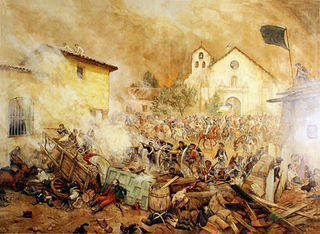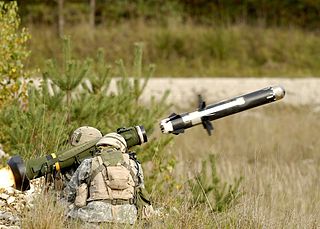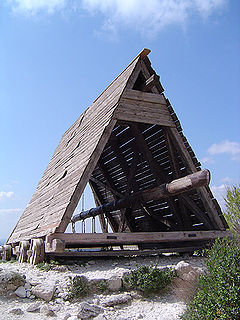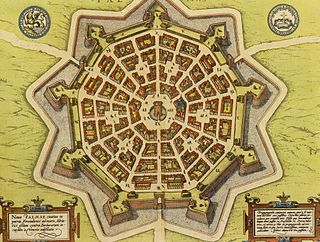
Artillery is a class of heavy military weapons built to fire munitions far beyond the range and power of infantry's small arms. Early artillery development focused on the ability to breach defensive walls, and fortifications during sieges, and led to heavy, fairly immobile siege engines. As technology improved, lighter, more mobile field artillery cannons developed for battlefield use. This development continues today; modern self-propelled artillery vehicles are highly mobile weapons of great versatility providing the large share of an army's total firepower.

A siege is a military blockade of a city, or fortress, with the intent of conquering by attrition, or a well-prepared assault. This derives from Latin: sedere, lit. 'to sit'. Siege warfare is a form of constant, low-intensity conflict characterized by one party holding a strong, static, defensive position. Consequently, an opportunity for negotiation between combatants is not uncommon, as proximity and fluctuating advantage can encourage diplomacy. The art of conducting and resisting sieges is called siege warfare, siegecraft, or poliorcetics.

An anti-tank guided missile (ATGM), anti-tank missile, anti-tank guided weapon (ATGW) or anti-armor guided weapon is a guided missile primarily designed to hit and destroy heavily armored military vehicles.

A siege engine is a device that is designed to break or circumvent heavy castle doors, thick city walls and other fortifications in siege warfare. Some are immobile, constructed in place by sappers to attack enemy fortifications from a distance, while others have wheels to enable advancing up to the enemy fortification. There are many distinct types, such as siege towers to allow attacking soldiers to scale walls and attack the defenders, battering rams to break walls or gates, to catapults, ballistae, trebuchets and other similar constructions used to attack from a distance and fire a projectile; some complex siege engines were combinations of these types.

A combat engineer is a soldier who performs a variety of construction and demolition tasks under combat conditions.

A parapet is a barrier which is an extension of the wall at the edge of a roof, terrace, balcony, walkway or other structure. The word comes ultimately from the Italian parapetto. The German equivalent Brüstung has the same meaning. Where extending above a roof, a parapet may simply be the portion of an exterior wall that continues above the edge line of the roof surface, or may be a continuation of a vertical feature beneath the roof such as a fire wall or party wall. Parapets were originally used to defend buildings from military attack, but today they are primarily used as guard rails and to prevent the spread of fires.

Strafing is the military practice of attacking ground targets from low-flying aircraft using aircraft-mounted automatic weapons.
Less commonly, the term can be used—by extension—to describe high-speed firing runs by any land or naval craft using smaller-caliber weapons and targeting stationary or slow-moving targets.

Enfilade and defilade are concepts in military tactics used to describe a military formation's exposure to enemy fire. A formation or position is "in enfilade" if weapons fire can be directed along its longest axis. A unit or position is "in defilade" if it uses natural or artificial obstacles to shield or conceal itself from enfilade. The strategies named by the English use the French enfiler and défiler, which the English nobility used at that time.

Air combat manoeuvring is the tactical art of moving, turning and/or situating one's fighter aircraft in order to attain a position from which an attack can be made on another aircraft. Air combat manoeuvres rely on offensive and defensive basic fighter manoeuvring (BFM) to gain an advantage over an aerial opponent.

Property insurance provides protection against most risks to property, such as fire, theft and some weather damage. This includes specialized forms of insurance such as fire insurance, flood insurance, earthquake insurance, home insurance, or boiler insurance. Property is insured in two main ways—open perils and named perils.

A bastion fort or trace italienne, is a fortification in a style that evolved during the early modern period of gunpowder when the cannon came to dominate the battlefield. It was first seen in the mid-15th century in Italy. Some types, especially when combined with ravelins and other outworks, resembled the related star fort of the same era.

Company of Heroes is a 2006 real-time strategy video game developed by Relic Entertainment and published by THQ for the Microsoft Windows and OS X operating systems. It was the first title to make use of the Games for Windows label.

The meteor hammer, often referred to simply as meteor, is an ancient Chinese weapon, consisting at its most basic level of two weights connected by a rope or chain. One of the flexible or "soft" weapons, it is referred to by many different names worldwide, dependent upon region, construction and intended use. Other names in use include dai chui, flying hammer, or dragon's fist. It belongs to the broader classes of flail and chain weapons.

A barrel roll is an aerial maneuver in which an airplane makes a complete rotation on both its longitudinal and lateral axes, causing it to follow a helical path, approximately maintaining its original direction. It is sometimes described as a "combination of a loop and a roll." The g-force is kept positive on the object throughout the maneuver, commonly between 2–3 g, and no less than 0.5 g. The barrel roll is commonly confused with an aileron roll.
Anti-surface warfare is the branch of naval warfare concerned with the suppression of surface combatants. More generally, it is any weapons, sensors, or operations intended to attack or limit the effectiveness of an adversary's surface ships. Before the adoption of the submarine and naval aviation, all naval warfare consisted of anti-surface warfare. The distinct concept of an anti-surface warfare capability emerged after World War II, and literature on the subject as a distinct discipline is inherently dominated by the dynamics of the Cold War.

Fort Foote was an American Civil War-era wood and earthwork fort that composed a portion of the wartime defenses of Washington, D.C., by helping defend the Potomac River approach to the city. It operated from 1863 to 1878, when the post was abandoned, and was used only briefly during the First and Second World Wars. Today, the fort is operated as Fort Foote Park, which is maintained by the U.S. National Park Service as part of the National Capital Parks-East system. The area's mailing address is Fort Washington, MD.

Sapping is a term used in siege operations to describe any trench excavated near an attacked, defended fortification, under defensive small arms or artillery fire. The trench, referred to as a "sap", is intended to advance a besieging army's position in relation to the works of an attacked fortification. The sap is excavated by brigades of trained soldiers, often called sappers. The sappers dig the trenches or specifically instruct the troops of the line to do so.

A ditch in military engineering is an obstacle, designed to slow down or break up an attacking force, while a trench is intended to provide cover to the defenders. In military fortifications the side of a ditch farthest from the enemy and closest to the next line of defence is known as the scarp while the side of a ditch closest to the enemy is known as the counterscarp.

Fort Morris Historic Site is a Georgia state historic park in Liberty County, Georgia in the United States. The fort is on a bend in the Medway River and played an important role in the protection of southeast Georgia throughout various conflicts beginning in 1741 and ending in 1865 at the conclusion of the American Civil War, including the French and Indian and American Revolutionary Wars and War of 1812. The historic site is 70 acres (28 ha) and sits at an elevation of 23 feet (7.0 m).




















